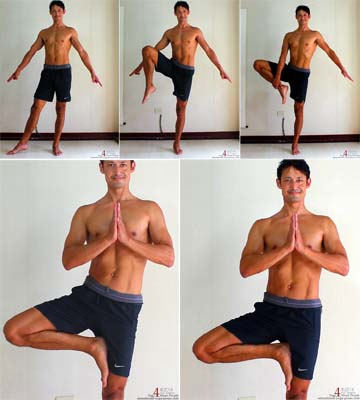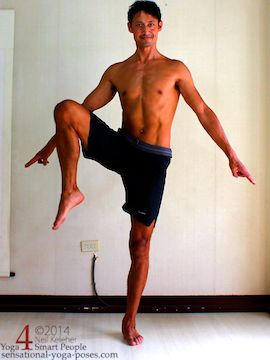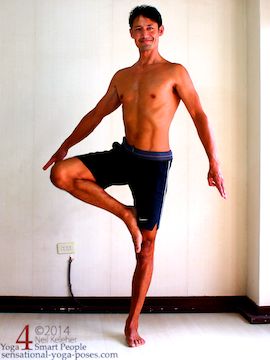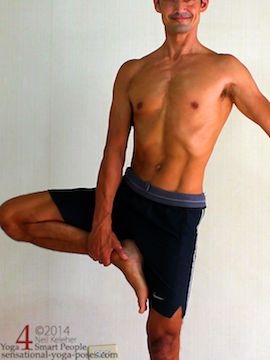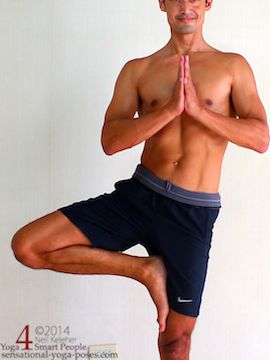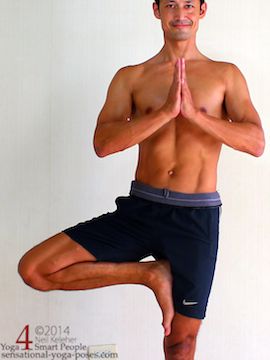Finding Balance In Yoga Tree Pose
in More Ways than One
If you have difficulty with balancing in yoga tree pose, you can try shifting your weight forwards so that your toes press down into the floor. You can then use your toes to help you balance.
Prior to leaning forward, you may have to activate your foot so that the bones of your foot and ankle support each other.
Once you have stabilized your ankle you may then find it easier to use your toes to help you balance.
Difficulty Balancing in Tree Pose? Activate Your Feet
If you have week feet or ankles, or have difficulty controlling them, you can practice activating your feet while standing on both feet.
From there, you can try pressing the inner thigh of your standing leg backwards while keeping your knee pointing straight ahead. You may find that this action helps to make your standing leg more stable.
Do this while pressing foot into your inner thigh. (And press with the front of the foot and the heel.)
You can also work on resisting the foor pressure with the inner thigh of your standing leg. So as you press your foot into your inner thigh, press your inner thigh against your foot.
Some people find that in tree pose one side is easier than the other. Hopefully the following instructions can be used to help make both sides a little bit more equal.
Weight Shifting from Front to Back
So that you can get used to controlling your center while in yoga tree pose, you can practice shifting your weight forwards and backwards while balancing on both feet.
With your feet active, move your body forwards so that all of your weight is evenly on the fronts of your feet. In this position the fronts of your feet and toes should press down with equal pressure.
- Balance here and keep your weight in the same place.
- Your heels should be able to easily lift off of the floor.
Now shift your weight so that it is over your heels. Allow the fronts of your feet to lift.
See how long you can balance in either position.
Use Your Toes to Help You Balance
You probably noticed that it was easier to balance with your weight over the fronts of your feet. That's because you could use your toes to help control your balance. Ideally you'll learn to balance easily on the fronts of your feet and on your heels but for now, you can practice balancing on one foot with your weight forwards. Use your toes to help you balance!
Your weight doesn't have to be all the way forwards, just forwards enough that your toes naturally press the floor. So, with both feet on the ground and your weight centered between them shift your weight forwards enough that your toes press into the floor. Remember to activate your feet first!
Now shift your weight onto your right foot. Feel the inner and outer edges of your right foot pressing down with equal pressure. Lift your left foot and balance.
Try the same thing on the other foot.
Switch back to your original foot and place your lifted foot against your inner thigh in tree pose. If you need to use your hand to help. Press your inner thigh with your heel and with your forefoot. Feel your knee reaching to the side and your hip joint opening.
If you can't get your foot up to your inner thigh then place it lower on your leg. Gradually work at lifting it higher.
Keep your center of gravity over your standing foot.
Stay aware of your standing foot and lengthen your tree pose upwards.
Smoothly and gradually lift your ribs up and away from your pelvis. Move your shoulders forwards so that your shoulder blades spread. Then reach your arms forwards and up so that your shoulder blades stay spread. Touch your hands together.
As an option you can also place your hands in front of your heart.
Can you do this with your eyes closed?
A Preparation Exercise for Yoga Tree Pose
Turn the right leg out 90 degrees. Rotate the thigh at the hip so that the knee and foot are turned out.
Lift the knee to the side keeping the thigh externally rotated at the hip. Give your right knee room to move higher by lifting the right hip higher also.
Work at closing the back of the knee joint so that the foot moves towards the opposite thigh. Note that as you lift the knee higher you actually move the foot further away from the thigh. But that is fine since the intent in this position is on lifting the knee and hip higher.
After holding for a few breaths use your hand to help position your foot on the inner thigh of the other leg.
With your foot against your inner thigh, gradually press the hip of the lifted leg down and at the same time press the foot against the inner thigh.
Resist with the standing leg, press the inner thigh against the foot.
To stay balanced, do all adjusting actions smoothly and slowly.
Do all "activations" (and that includes relaxing) slowly and smoothly so that it is easier to maintain balance.
Even if you are using a wall for support practice activating and relaxing smoothly and slowly so that you can do the same when you finally do start practicing balance at the same time.
Balancing the Sides in Yoga Tree Pose
If you find that one side is easier than the other in yoga tree pose, practice the hard side first, do the easy side and then do the hard side again.
Notice the differences in sensation between the hard side and the easy side. Look for a lack of sensation or excessive tension in the hard side compared to the easy side. Try to create sensation where it is lacking and try to reduce excessive tension.
Moving Between Isolated Awareness and Whole Body Awareness
When fault finding yoga tree pose, this is the time to move away from focused or isolated awareness to "all over" body awareness. You may find that if you focus too much on one thing you don't notice what's going on in other parts of the body.
And so move smoothly between isolated awareness and all over awareness. Where you find areas of interest, zoom in and isolate, and then zoom back out again.
For more single leg balancing, and how to stay balanced, check out Balancing on One Foot.
Staying Balanced While Moving into Tree Pose
Note that I think of tree pose as similiar to binding poses because one foot presses against the other thigh.
- The act of touching the foot to the thigh and then pressing it inwards (or the act of holding on to the foot to position it and then letting go) can upset your balance.
So when placing the foot against the thigh, and when letting go of the foot after positioning it, try to move slowly and smoothly.
- Try gradually releasing the foot if you are holding on to it. If you want to press the foot into the inner thigh, try to gradually press the foot into the inner thigh.
- And while doing either of these actions pay attention to your standing foot so that it is easier to stay balanced.
Published: 2014 04 30
